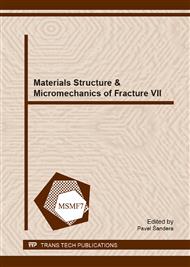p.239
p.246
p.250
p.254
p.258
p.262
p.266
p.271
p.275
Calibration of Selected Ductile Fracture Criteria Using Two Types of Specimens
Abstract:
This paper presents the calibration of three universal ductile fracture criteria with the stress triaxiality and the normalized third invariant of deviatoric stress dependence. Xue-Wierzbicki, Bai-Wierzbicki and Extended Mohr-Coulomb criteria are calibrated using butterfly specimen and newly designed notched tube specimen for an austenitic stainless steel. Different stress states necessary for successful calibration are generated by suitable combination of tension/compression-shear or tension/compression-torsion loading of both specimens, respectively. Suitability of the specimens for ductile fracture criteria calibration is evaluated comparing the range of reached stress states, the homogeneity of stress in process zone and appropriateness for the computational simulation of tests. Possible combination of above mentioned results with tensile testing of standard and notched cylindrical specimens is discussed, too.
Info:
Periodical:
Pages:
258-261
Citation:
Online since:
November 2013
Price:
Сopyright:
© 2014 Trans Tech Publications Ltd. All Rights Reserved
Share:
Citation:


